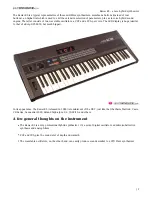
11
Modulation
- Modulation is the use of a CV to affect a voltage-controlled circuit.
Modulation has a source, destination, and amount. This could be as simple as the
filter cutoff of a VCF (a modulation destination) being changed by the front panel
cutoff control (the source), or as complex as mixing multiple CVs together to
modulate filter cutoff. Modulation is used in synthesis to create complex sounds
and add variation.
Envelope Generator -
An envelope describes the contours that affect the
characteristics of a sound as it evolves in time from its start to its finish. Take a
plucked string for example: when a string is plucked, its amplitude is suddenly very
loud, then dies out gradually. The initial part of the sound is very bright but then the
brightness fades away. The frequency of the sound goes slightly higher and then
drops slightly as the note fades. These kinds of changes in a sound over time can
be applied to oscillators, filters or the amplitude of an electronically generated
sound by an envelope generator. The envelope generator creates a CV that
describes the contours of a sound.
Attack,
measured in time, specifies the onset or
transient of a sound. With Volume for instance, the sound might start suddenly as
does a plucked string sound, or fade in slowly like a bowed string crescendo.
Decay
is also measured in time and specifies how quickly the onset of a sound
fades into the sustained portion.
Sustain
is the level at which a sound sustains after
the initial transient.
Release
is measured in time and determines how long a sound
takes to fade away after a note is released. These four components make up an
ADSR envelope generator. An envelope control signal has to be started and
stopped. The start and stop is triggered by what is called a
gate signal.
A gate
signal is either on or off. When it goes on, the Envelope generator is started, when
the gate goes off, the release segment of the envelope begins. (figure 9)




































